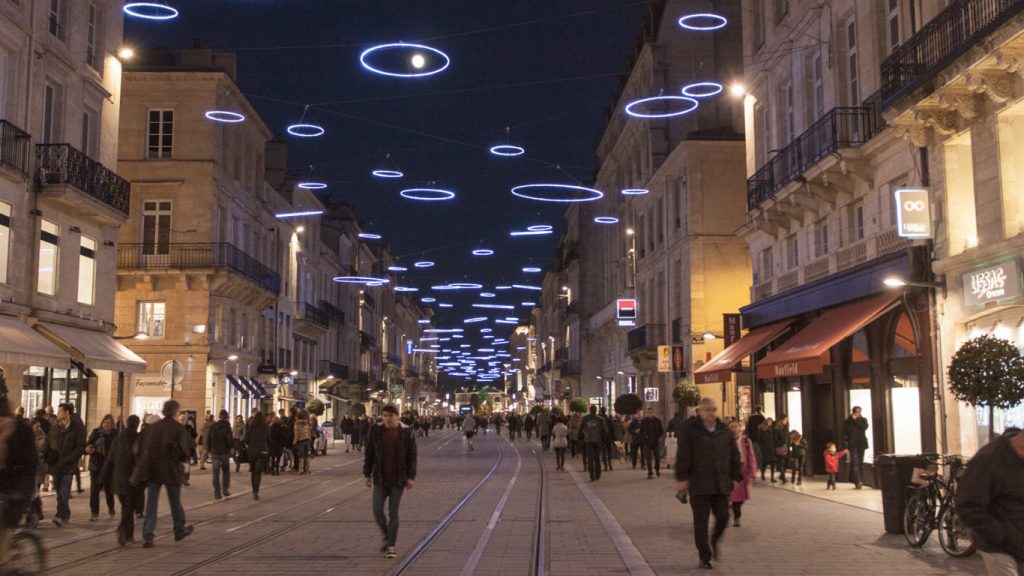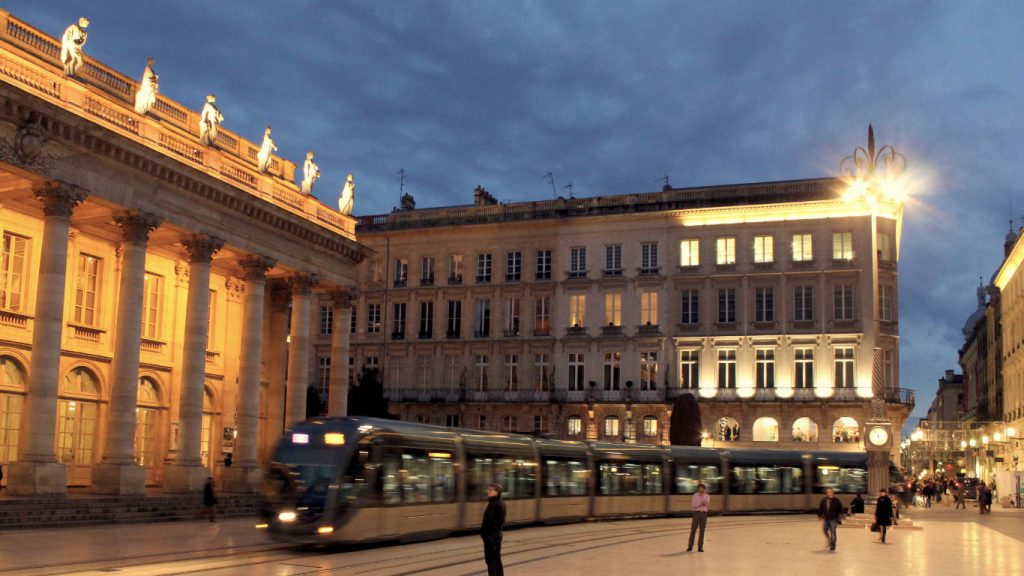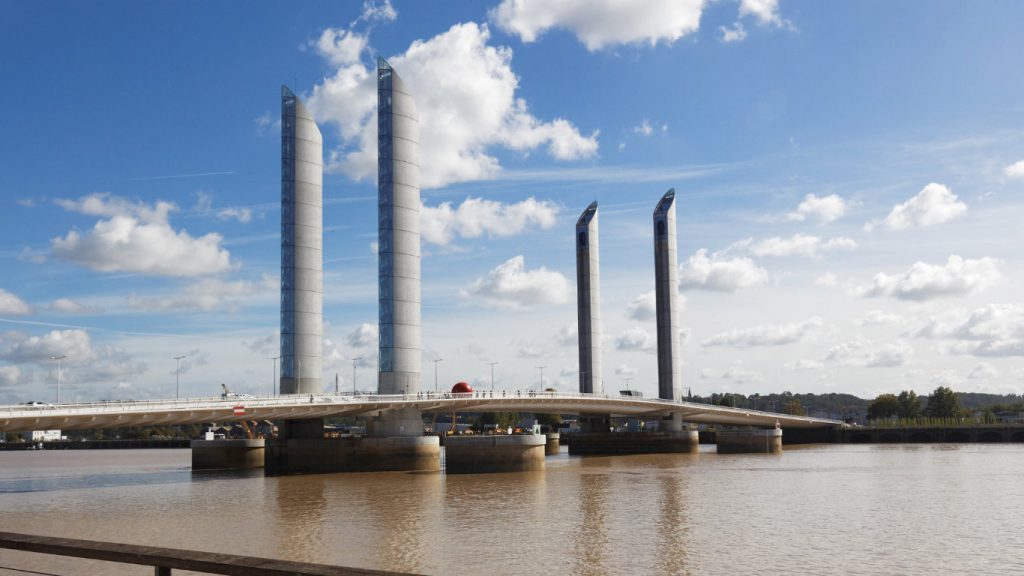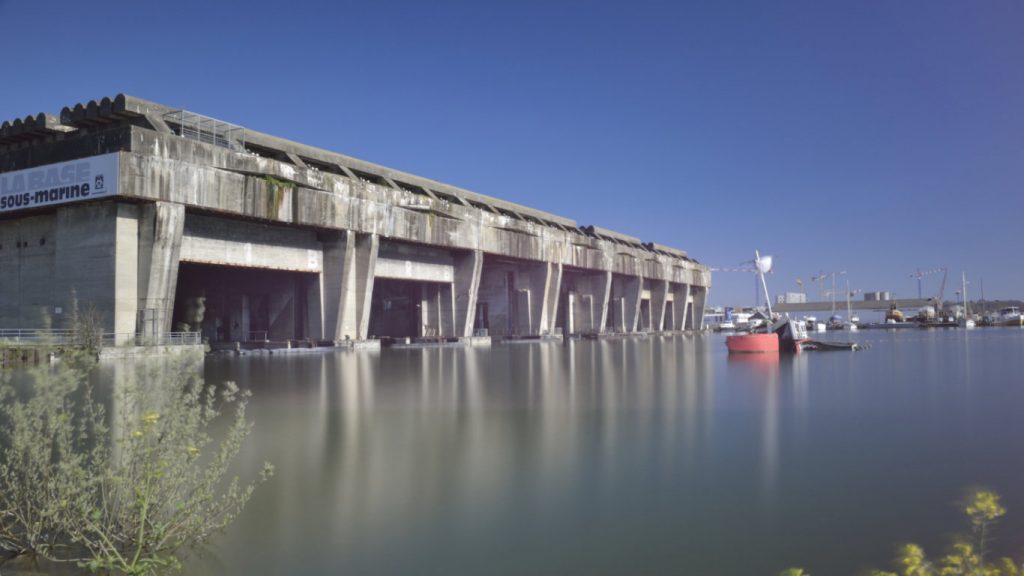
Bordeaux – one of France’s most beautiful and elegant cities
Bordeaux is a city of bustling markets, one-off boutiques that are shopping heaven, theatre and museums and a packed calendar of events. Then there are the fabulous restaurants and not forgetting, of course, the world-class wine. A wonderful city, not to be missed.
When in Bordeaux, stand on the Right Bank of the Garonne river, close to the Pont Saint Pierre, and look to the Left Bank where the river gently curves around the city.
The piercing spire of Saint-Michel basilica rises into the blue sky to the left of you, then a ribbon of elegant 18th century buildings that end near the double-spire of Notre Dame church to the right. The pale honey-coloured limestone glows warmly in the light, their splendid architectural features clear to see. It’s a magnificent spectacle that is unparalleled in the world which is why UNESCO designated it a World Heritage site in 2007.
If you happen to be in the city on a Sunday morning, cross the bridge and walk 20 minutes or so to the Quai des Chartrons for the weekly market. Here, urged on by the delicious aroma of roasting chickens and flambeed prawns, you can join the locals in buying the freshest oysters, delicious chestnut honey, finely cured sausages, pungent cheeses and bunches of fresh flowers, all whilst taking in the splendid view.
The riverside Chartrons quarter is a by-word for the regeneration of Bordeaux. Once little more than derelict warehouses, today it is a lively quarter of town with interesting little boutiques, great restaurants, market, and the city’s Museum of Modern Art. The rest of city-centre Bordeaux has been similarly transformed over the past decade or so. In the latter part of the twentieth century Bordeaux was known as ‘La Belle au Bois Dormant’ – Sleeping Beauty.

The Largest Urban World Heritage Site
The historic port city on the French Atlantic coast, famous for its trade in wine and spirits, was an uninspiring place, its buildings covered with layers of black grime that hid their beauty, access to the river blocked off by abandoned warehouses and the streets choked with traffic. It was a city to pass through, not to stop and savour. But no longer. In 1995 mayor Alain Juppé, kickstarted a huge regeneration programme that saw the waterfront opened up, the historic buildings cleaned, the city centre streets pedestrianised and a hi-tech tram system installed. It has been a resounding success.
Bordeaux’s UNESCO listing makes it the largest urban world heritage site and Bordeaux is now France’s second favourite city after the capital, Paris. The 21st century transformation is the second in the city’s history. In the 18th century Bordeaux was a medieval town with a tangle of filthy narrow lanes surrounded by swamp – the current city plan is largely the vision of three ‘intendants’ (representatives of Louis XV in the province of Aquitaine) who oversaw the city’s first great transformation. Claude Boucher, Marquis de Tourny and Nicolas-Dupré de Saint-Maur, chief town planner stretching over a sixty-year period, envisaged a well-planned city of wide boulevards, harmonious streets, magnificent buildings, gardens and busy quays. Despite local opposition they got their way, razing parts of the city to the ground to create tree-lined promenades, flanked by elegant buildings, and the majority of the city’s most emblematic buildings date back to this time. All of which makes Bordeaux a wonderful city to walk around, taking in the beauty of its architecture, from the grand buildings to the single-storey workers’ homes, its elegant squares and lovely parks. Keep an eye out for the ‘mascarons’ (from the Italian ‘mascherone’), masks made of stone that adorn many of the façades and are a feature of the city.
Exploring Bordeaux
We reckon the best way to see Bordeaux is to explore it by areas:
Old Town
As the name suggests, this is the oldest part of Bordeaux. Some 150 hectares of it are UNESCO-protected and within this are about 5,000 buildings that date back to the 18th century 350 are listed.
It is a fascinating area to walk around, with its mix of grand boulevards and narrow streets, neo-classical squares, stately mansions and historic monuments. Read more.
Les Chartrons
Bordeaux’s new funky neighbourhood, it’s narrow streets flanked by grand and not so grand workers homes that now house one-off fashion boutiques, interior design and vintage stores, foodie shops and cool cafes and restaurants. Read more.
Quartier Pey Berland
Situated around the cathedral, this area of Bordeaux that’s west of the Old Town is where you will find many of the major museums. The first and most obvious attraction, though, is the Cathedral Saint-André and its 15th century bell tower: Tour Pey Berland. If you have the stamina, climb the 229 steps to the top of the tower: the fabulous views of Bordeaux are well worth the effort.
Not far from the western side of the cathedral are the Musée des Beaux Arts and the Musée des Arts Decoratifs. The former has a good collection of paintings from the 15th – 20th century, in particular from the Renaissance period. The Musée des Arts Decoratifs is housed in an 18th century mansion with rooms recreated to show typical bourgeois rooms of the time as well as decorative objects from porcelain to ironwork. A short distance away is the Musée d’Aquitaine which traces the history of the area from prehistory to modern times.
The Right Bank
Bordeaux’s Left Bank gets all the attention but the Right Bank is definitely worth a visit too and not just for the stunning views of the Left Bank! Once largely ignored, it is now an attractive and interesting area that continues to develop.
An obvious starting point is Place Stalingrad, formerly known as Place du Pont, and situated directly off the old bridge, Pont du Pierre. The square is dominated by a sculpture of large blue lion, created by the Xavier Veilhan, one of France’s new generation of leading artists, and known for his bold and colourful works of art. Leading away from the square is Avenue Thiers, one of the main routes out of the city since 1826.
With its bright red paint blocks the Caserne des Pompiers de la Benauge is visible from afar. A fire station, built between 1950 and 1954 by a trio of French artists of the modernist movement: Claure Ferret, Adrien Courtois and Yves Salier, with the aluminium facade designed by world-famous Jean Prouvé. In 2008 it was listed under “Patrimoine du XXe siècle” and is now a protected example of 20th century architecture. Made up of distinct blocks, each has a different purpose. Above are five storeys of residential apartments, separated from the ground floor by a series of columns. The building will soon cease to be a fire-station and under current plans it will become part of the renowned culinary school Hôtelière de Lausanne, combining a hotel with a cookery school. It’s on the corner of Quai Deschamps and Benauge Street.
Eglise Saint Marie on rue Thiers is a 19th century church designed by Paul Abadie who was responsible for the Sacré-Cœur church in Montmartre, which explains the church’s dome-like top. What makes this church interesting is the backstory to its construction. Due to the unstable quality of the soil, the church is supported on foundations beneath the soil and the church is largely built of wood rather than stone.
Close by are what is now the main Jardin Botanique (Botanical Gardens). Just 600 metres long, they are the work of landscape artist Catherine Mosbach and architect Françoise-Hélène Jourda. The gardens are divided into a number of different types of gardens – the greenhouse is for Mediterranean plants (500 types can be found here); the ‘Vertical Garden’ showcases climbing plants; the ‘Gallery of Eco-Systems’ has re-created eleven natural landscapes of the Aquitaine Basin; there’s also an arboretum and a water garden that’s given over to aquatic plants. Enter the park from Quay des Queyries, Esplanade Linné, Jean Giono and allée Serr.
Opening hours: last weekend in March to the last weekend in October, every day 8am- 8pm. Last weekend in October to last weekend in March, every day 8am – 6pm. Glass house and exhibitions, 11am – 6pm everyday except Mondays and public holidays. Entry is free.
Bassins à Flot
A renovation work in progress, these docklands to the north of the city are still in the process of being turned into a Bordeaux hotspot and it all feels excitingly experimental. It’s where you find one of the city’s coolest spaces, Le Garage Moderne, a non-profit association that’s an unusual combination of working garage for cars and motorbikes as well as an exhibition space and party venue. Its offices are housed into two vintage buses. It holds many very popular cultural events, softening the rather stark ambience with fairy lights and candles.
Base sous-marine
A fifteen minute walk from here is Base sous-marine, one of five bunkers built along the coast to house German U-boats as well as supply boats and other military vessels. The bunker’s statistics are sobering – 245 metres long, 162 metres wide, 19 metres high and with a roof that is an almost indestructible 9.20 metres thick. An amazing 600,000 cubic metres of concrete went into building it. The hard labour was done by up to 6,000 workers, mainly Spanish and Portuguese prisoners of war who worked under terrible conditions; many died and today there is a memorial to those who lost their lives. With a heavy and haunting atmosphere, it is now an occasional exhibition space, as well as a venue for festivals and performing art events. It’s not open to the public unless an event is on so check before you go. Reach it by taking the Line B tram; the stop is called ‘Bassins a flot’.
Read more about what so see and do in Bordeaux, here.
Getting around Bordeaux
Trams and Busses
The city’s restructuring saw the introduction of a sophisticated tram system and this, along with an extensive bus network, ensures that getting around the Bordeaux is not difficult. Also part of the public transportation system is a ferry along the river. The trams began running in 2003 and run with APS technology – their electricity supply comes from the ground and not from overhead wires. There are three tram lines: A, B and C and these connect to the more than 70 bus lines. Both the trams and buses run seven days a week, from 5am to 1am although the service is less frequent after 9pm. Note: there are no trams or buses at all on May 1, the May Day (Labour Day) bank holiday.
Buy your tickets at ticket machines at tram stops and in one of the many tabac presse around town. Bus drivers will take cash for a single journey ticket. You must validate your ticket in the machine when you board.
The ferry
Batcub, runs along the river between Lormont Bas, Les Hangars, Quinconces and Place Stalingrad. It runs from May to the end of December and fares are as for the buses and trams. As well as getting around, they’re a great way of seeing the city from the river; they even go under the impressive new bridge, Pont Chaban Delmas. Information (in French) on trams, buses and the ferry can be found at www.infotbc.com.
Bordeaux Metropole City Pass
This citypass gives you free or discounted access to many of Bordeaux’s attractions and transport system, and is well worth the money if you’re planning on an intensive visit. The pass is available for one, two or three days and gives you:
Free access to the public transport system trams, buses and ferries; guided walks with the tourist office; tour of the city in a red double-decker bus; free admission to more than 15 museums and UNESCO-listed monuments including the Flèche Saint-Michel, Porte Cailhau, Grosse cloche, Musée Aquitaine, Musée Beau-Arts, CAPC, Centre de Jean Moulin, Musée des Arts Decoratifs,
Reduced ticket price on/at: ‘Le Petit Train touristique’ the little train that drives around the city; Imayana Step Back in Time interactive guide; River cruise Tour Pey-Berland Musée du Vin et du Negoce a half-day wine tour (Wednesdays, Saturdays and Sundays)
Buy the Bordeaux Metropole City Pass at the tourist information office or online.
Tourist information office: Town centre: 12 Cours du 30 Juillet; Tel: 05 56 00 66 00. Open every day; Saint-Jean train station: Parvis Louis Armand rue Charles Domercq; Tel: +33 5 56 91 64 70.
Getting to Bordeaux
Bordeaux has excellent connections and is easy to get to whatever your mode of transport.
Plane
Bordeaux Merignac Airport is 10 kilometres to the west of the city in the small village of Merignac. It is an international airports with direct flights to many other cities in Europe.
A shuttle bus operates between the airport and the main train station Gare Saint-Jean. It takes 30 minutes in normal traffic conditions but when going to the airport, do allow for delays. The bus runs every day, all year round from 6am – 9pm from the train station; between 8am and 11pm from the airport. There is one bus an hour. At the airport the bus stop is directly outside the main building on the ground floor – outside Hall B main exit. From Gare Saint-Jean the bus stop is directly outside the exit for Rue Charles Domercq (between the tram line stop and the station building).
Bus number one (line #1) goes from the city centre to the airport with a number of stops along the way. It also connects with a number of tram lines so you can connect from the bus to the tram (or vice versa) easily. The bus is frequent – every 10 minutes or so on weekdays, every 15 minutes on Saturdays and every 20 – 30 minutes on Sundays. The journey takes about 45 minutes and costs 1.40 (the cost of a single ticket). At the airport: the bus stop is directly outside Halle B on the arrivals level, near the stop for the Navette Shuttle. In the city: the bus begins at Place des Quinconces, on the south side of the square) and stops throughout the city. As the bus and tram stops are near each other and on the same side of the road, it is relatively easy to connect between the two, even with luggage. At the airport the bus stops outside the arrivals areas, nearer to Hall A.
There are a number of taxis that operate between the airport and the city centre: expect to pay in the region of €25. For a list of recognised taxi companies see here.
You can also travel by motorbike taxis. If you are disabled and need specially adapted vehicles.
Train
Bordeaux is connected to Paris by the TGV with a journey time of about three hours and 10 minutes. There are also train connections to a number of others towns throughout the region. The train station is located about three kilometres from the city centre on rue Charles Domercq. Tram C takes you from right outside the station to the city centre. It meets Line A at Porte de Bourgogne and Line B at Quinconces allowing you to connect to other parts of the city quickly and easily. The first tram is just after 5am and run every eight to nine minutes until 10pm, then every 15 or so minutes to midnight. On Sunday and public holidays however, they only run every 30 minutes. For more information see www.infotbc.com.
Photo 1 by kixmi71 / CC BY 2.0 image cropped; Photo 3 by Manu Dreuil / CC BY 2.0 image cropped; Photo 4 by desmarepix / CC BY 2.0 image cropped; Photo 5 by Jean Baptiste ROUX / CC BY 2.0 image cropped; Photo 7 by Jerome / CC BY 2.0 image cropped





